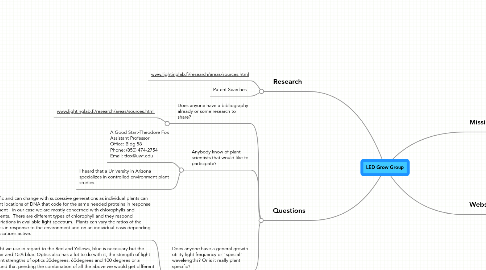
1. Research
1.1. www.lightinglab.fi/research/areas/sources.html
1.2. Patent Searches
2. Questions
2.1. Does anyone have a bibliography already or some research to share?
2.1.1. www.lightinglab.fi/research/areas/sources.html
2.2. Anybody know of plant scientists that would like to participate?
2.2.1. A Good Start-Theodore Fox Assistant Professor Office: Bldg 58 Phone: (850) 474-2754 Email: tfox@uwf.edu
2.2.2. I heard that a University in Arizona specializes in controlled environment plant studies.
2.3. Does anyone have a general growth utility light frequency or "special" wavelengths? Or is it really plant specific?
2.3.1. It is plant specific and can change with successive generations as individual plants can activate different locations of DNA that code for the same needed proteins in response to the environment - in our case we are mostly concerned with chlorophylls and accessory pigments. There are different types of chlorophyll and they respond differently to variations in available light spectrum. Plants can vary the ratios of the chlorophyll types in response to the environment and on an individual basis depending on DNA/RNA locations active.
2.3.2. Everyone it is all about the wave lengths of light we use in regard to the Red and Yellows, blue is necessary but the ratio to red and blue is like 75% red 10% amber and 15% blue. Optics also has a lot to do with it, the strength of light directly effects how plants grow, so use different strengths of optics 30degrees, 60degrees and 100 degrees or a variation. When I was doing my testing, we found that pending the combination of all the above we would get different results in growth, for instance the plant would grow really quick but the trunk would be very thin, or the exact opposite would occur. It is all a formula. For the question above, I would use use a combination of deep red led's and red/orange amber Leds, with a hint of blue. This is science and we should have a group just on this subject so we can all test different combinations of optics, led's to find the best formulas to grow and sustain growth of every plant species.
2.3.3. Currently there are two and maybe three colors that will enhance plant growth. Next to that it is the ratio and intensity that matters. But very simple Red (660>670Nm) will let a plant grow vertically and Blue (430>440Nm) will grow a plant horizontally. In Holland for example there been done a lot of trials and test already and they are now rolling out Commercial applications. Here in NZ we have sold to a big Tomatoes grower and a Grass Research center for example. We know that the wave length and ratio we use are correct and plants response correctly on it but it is more how to interact with LED growlights, Irrigation, heating needs etc. what is the trick!!
